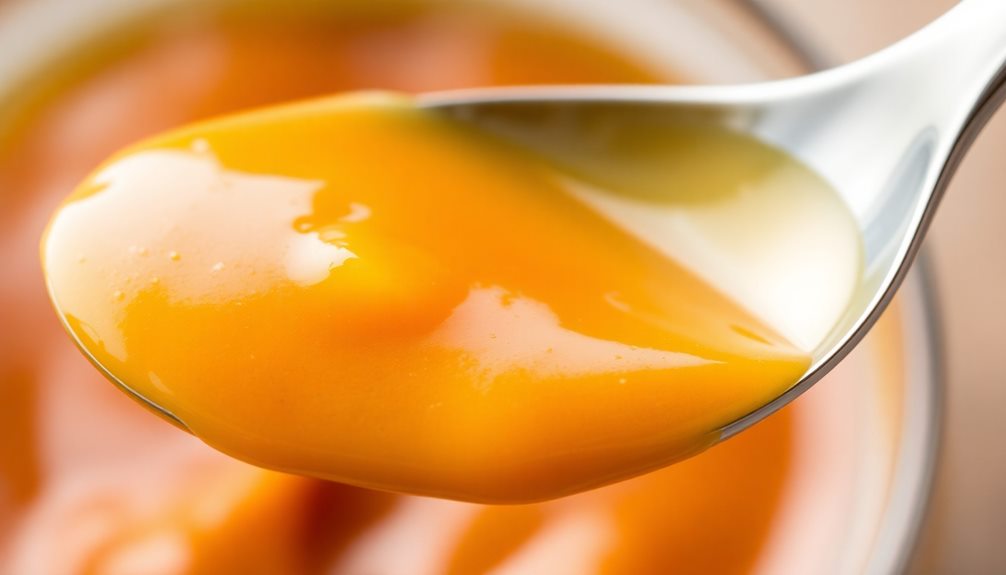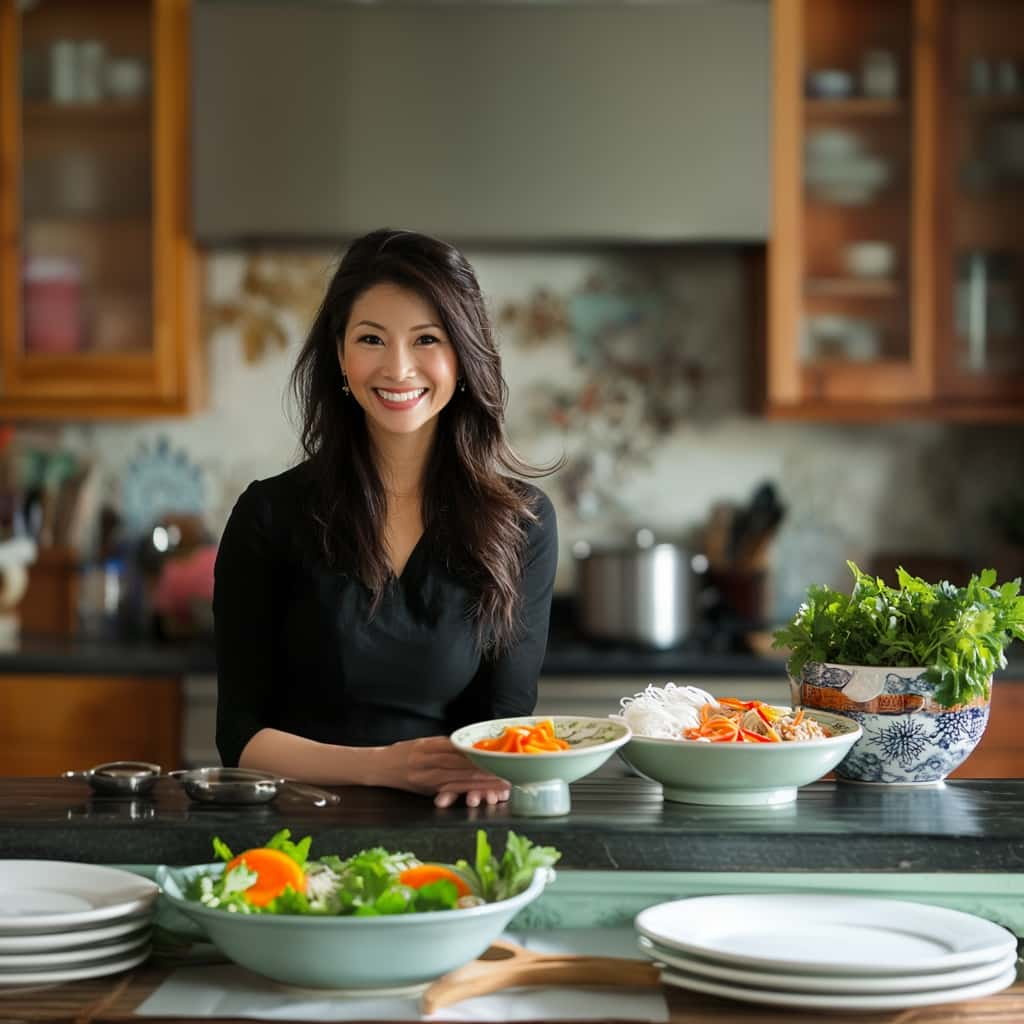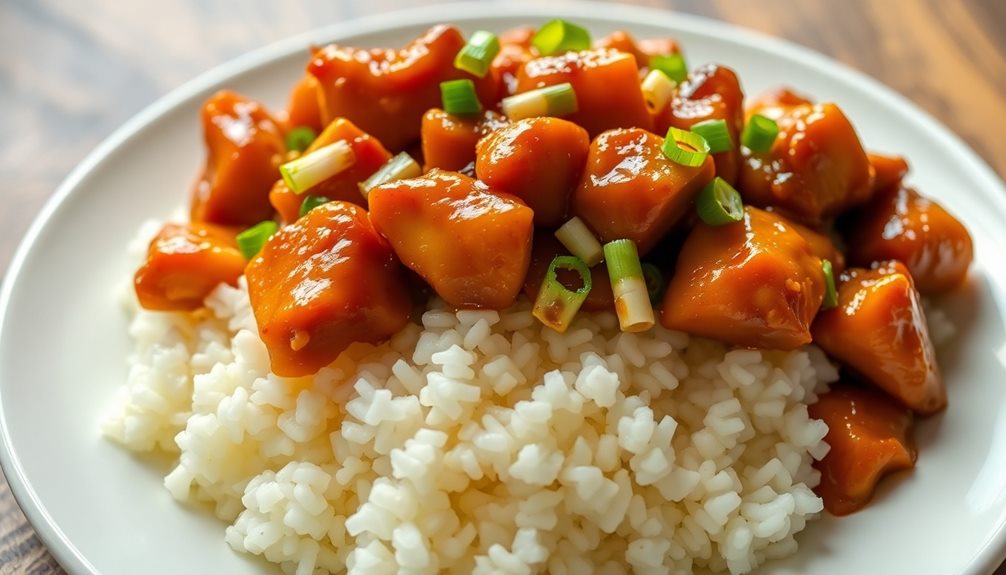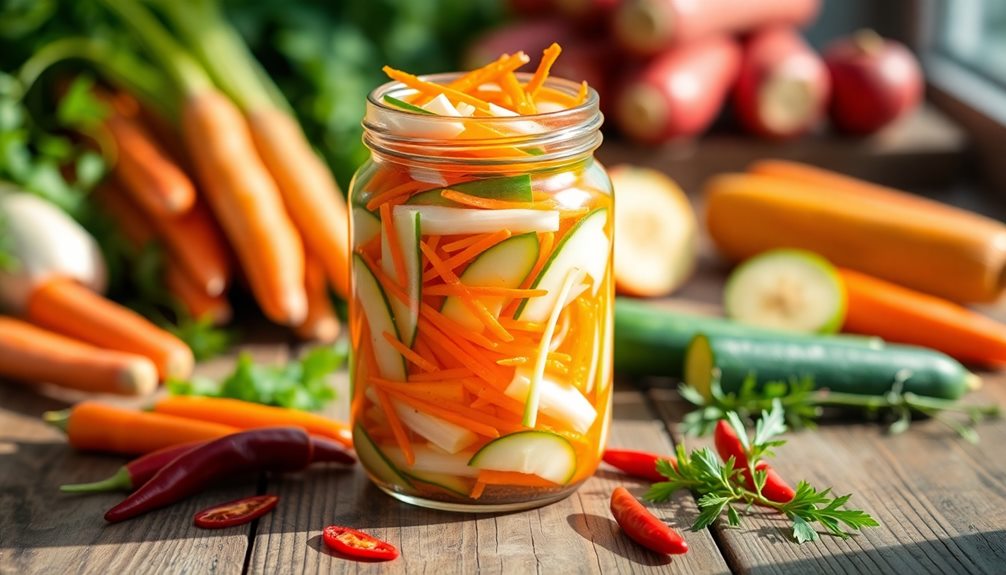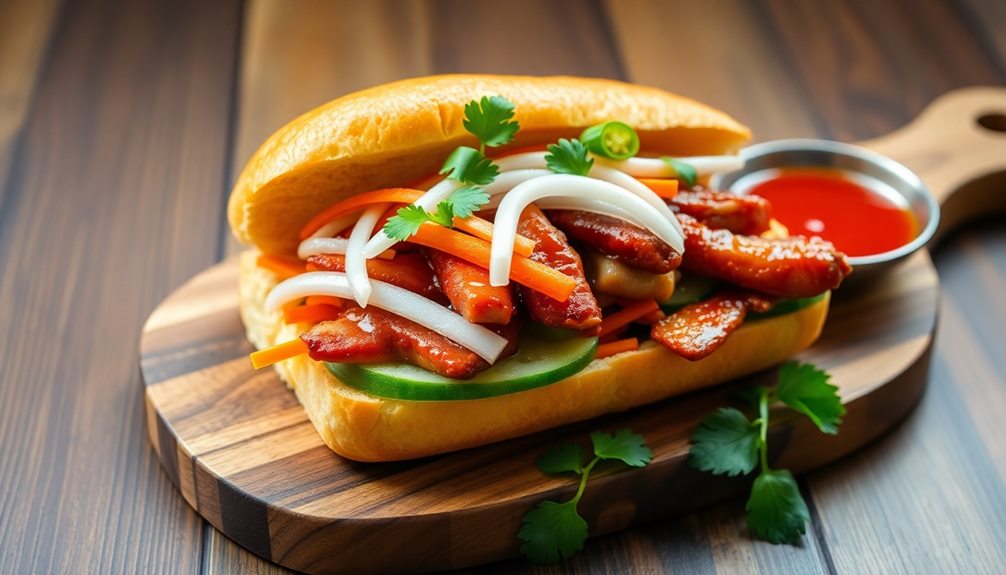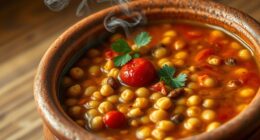Bánh Chưng is a delicious Vietnamese sticky rice cake that's perfect for celebrations like the Lunar New Year! It symbolizes family and togetherness, with its square shape representing the Earth. To make it, you soak glutinous rice overnight, blend it with soft mung beans, and wrap it all in banana leaves. After tying it up, you steam the packages for two hours. Once cool, Bánh Chưng can be sliced and shared, often served with pickled veggies for a tasty mix. Enjoying this cake brings everyone closer! Stick around to discover more about its rich history and cooking traditions.
Key Takeaways
- Bánh Chưng is a traditional Vietnamese sticky rice cake, symbolizing the connection to ancestors and family unity, especially during Lunar New Year (Tết).
- It consists of glutinous rice, mung beans, and pork belly, wrapped in banana leaves and steamed for a rich flavor and texture.
- The cake's square shape represents the Earth, reflecting Vietnam's cultural heritage and agricultural roots.
- Preparation involves teamwork, encouraging family bonding and the transmission of cultural practices to younger generations.
- Bánh Chưng is often served warm or at room temperature, accompanied by pickled vegetables for a balanced flavor experience during festive occasions.
History
The rich tradition of Bánh Chưng reflects the deep cultural heritage of Vietnam. This sticky rice cake has a fascinating history that goes back thousands of years. Legend says that it first appeared during the reign of the sixth king of the Hùng dynasty. The king wanted to find a successor, so he challenged his sons to create a dish that represented their homeland. The youngest son, Lang Liệu, made Bánh Chưng, symbolizing the Earth with its square shape. His clever idea won the king's heart and secured his spot as the next ruler.
Bánh Chưng isn't just a tasty treat; it's also a symbol of family and togetherness. Families gather to prepare and eat it during the Lunar New Year, known as Tết. This special time brings everyone closer, reminding them of their roots and traditions.
It's amazing how a simple cake can carry so much meaning!
As you learn more about Bánh Chưng, you'll discover how cooking and sharing this delicious dish can connect you to a rich cultural history. So, get ready to dive deeper into the delightful world of Bánh Chưng and its significance in Vietnamese life!
Cooking Steps
To create delicious bánh chưng, start by soaking the glutinous rice and mung beans overnight to ensure they soften adequately.
The next day, rinse the rice and beans well. Then, cook the mung beans until they're soft and mash them into a smooth paste.
Now, it's time to prepare the pork! Cut the pork belly into small pieces and marinate it with salt, pepper, and some green onion. This will add a tasty flavor.
After that, take your soaked rice and layer it in a large bowl. Add a layer of mung bean paste and then a layer of marinated pork. Repeat the layers until you've used all your ingredients.
Once everything's layered, cover the mixture with more rice and then wrap it tightly in banana leaves. Make sure to tie it securely with kitchen twine.
Now, boil the wrapped cakes in a large pot for about 6 to 8 hours. Keep an eye on the water level, adding more if needed.
Step 1. Soak Glutinous Rice Overnight

Soaking glutinous rice overnight is essential for achieving the perfect texture in your bánh chưng. This step is super important because it helps the rice absorb water, making it soft and sticky.
When you're ready to start, grab a bowl and measure out the glutinous rice you'll need. Rinse the rice under cold water to remove any dust and impurities. It's like giving it a little bath!
After rinsing, place the rice in the bowl and cover it with water. You want to ensure there's enough water to submerge the rice completely. Let it soak for at least eight hours, or even better, overnight. This gives the rice time to plump up and prepare for cooking.
While you wait, think about how delicious your bánh chưng will be! Imagine the flavors and the fun of sharing it with family during celebrations.
Once the soaking time is up, drain the rice well. Now you're ready for the next steps in making your special sticky rice cake. So, don't rush this part; it's crucial for that delightful texture you're aiming for! Enjoy the process and the yummy results that'll come!
Step 2. Blend With Mung Beans

Now that your glutinous rice is perfectly soaked, it's time to blend it with mung beans to create a delicious filling for your báng chưng.
First, you'll want to cook your mung beans until they're nice and soft. This usually takes about 20 minutes. Once they're cooked, drain any extra water and let them cool for a bit.
Next, grab your blender or food processor. You'll add the cooked mung beans and a pinch of salt. Blend everything together until you get a smooth, creamy mixture. If you like a bit of texture, don't blend it too much! It should still have a little chunkiness to it.
Now, take your soaked glutinous rice and drain it. In a large bowl, combine the rice with the mung bean mixture. Mix it well, so every grain of rice gets some of that yummy goodness. You can even use your hands to make sure it's all blended together nicely.
Once you've got a uniform mixture, you're ready for the next exciting step! Your filling is now perfect and waiting to be wrapped into the báng chưng.
Enjoy the process; you're making something special!
Step 3. Wrap in Banana Leaves

With your mung bean filling mixed into the soaked glutinous rice, it's time to wrap everything in banana leaves.
First, grab a few fresh banana leaves and cut them into rectangles about 10 inches long. These will be your wrappers! Lay one leaf flat on your work surface with the shiny side facing down.
Scoop some of your rice mixture onto the center of the leaf. Make sure to leave some space on the edges. Next, place a spoonful of the mung bean filling right in the middle of the rice.
Now, fold the sides of the banana leaf over the rice and filling, like you're making a little package. Then, fold up the ends to seal it all in.
You want to make sure it's tightly wrapped, so nothing spills out. If you have some kitchen twine or strips of banana leaves, tie your package securely. This keeps everything together while cooking!
Repeat this process until you've wrapped all your rice cakes. Isn't it exciting to see your bánh chưng taking shape? You're just one step closer to enjoying this delicious treat!
Step 4. Steam for Two Hours
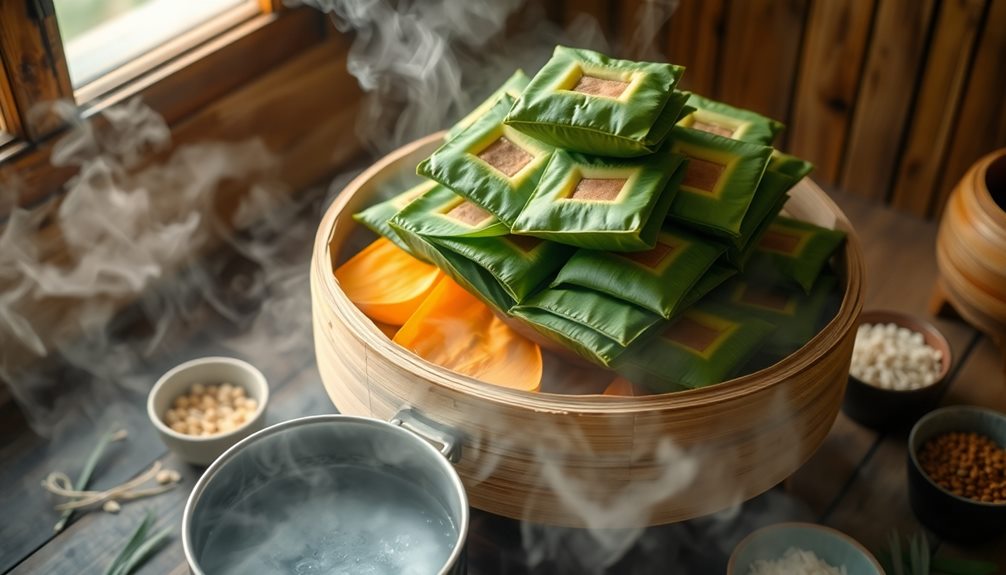
Once your bành chưng is securely wrapped, it's time to bring it to life through steaming. First, gather a large pot and fill it with water. Make sure the pot has enough space to hold your bành chưng without crowding.
Place a steaming rack or bamboo steamer at the bottom to keep the cakes above the water. Carefully arrange your wrapped bành chưng on the rack, making sure they're not stacked too high. You want them to steam evenly, so give them some breathing room.
Cover the pot with a tight lid to keep the steam in. Now, turn on the heat and watch the magic happen! Steam your bành chưng for about two hours. You might want to check the water level occasionally—add more hot water if it gets too low.
The aroma will fill your kitchen, making everyone excited about what's coming! After two hours, your bành chưng will be beautifully cooked, and the flavors will blend perfectly.
It's a delightful moment when you know you're one step closer to enjoying this delicious treat. Get ready for the next steps, as the best is yet to come!
Step 5. Cool Before Serving
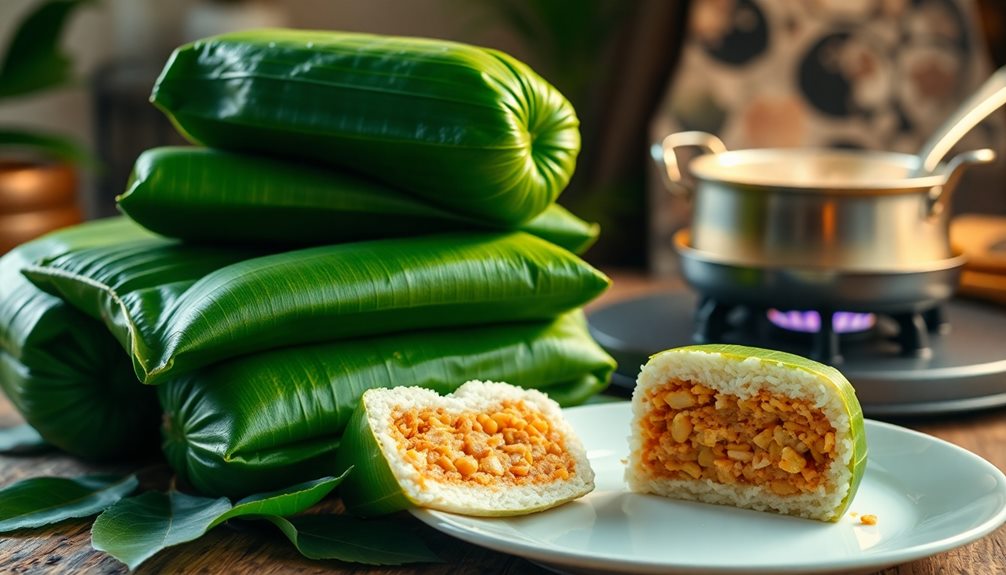
After steaming, give your bánh chưng a moment to cool down before serving. This step is important because the cake will be super hot, and you want to avoid any burns! Let it sit for about 30 minutes. You can leave it in the steamer or place it on a cooling rack.
While it cools, you can smell the delicious aroma of the sticky rice and mung beans! Isn't that exciting?
Once it's cool enough to handle, take it out of the wrapping. You'll see the beautiful layers of rice and filling.
Now it's time to slice your bánh chưng into pieces. Use a sharp knife, and cut straight down to make even pieces. This way, everyone can enjoy a fair share! You can serve it as is or pair it with some pickled vegetables for a tasty contrast.
Don't forget to share with family and friends; food is always better when enjoyed together! Your bánh chưng isn't just a treat; it's a celebration of culture and love. Enjoy every bite, and don't be surprised if everyone asks for seconds!
Final Thoughts
Bánh Chưng is more than just a delicious treat; it's a symbol of Vietnamese culture and tradition. When you take a bite of this sticky rice cake, you're not just tasting the flavors of mung beans and pork; you're also experiencing a piece of history.
This special cake is often enjoyed during important celebrations like Tết, the Vietnamese Lunar New Year, bringing families together to honor their ancestors and share stories.
Making Bánh Chưng can be a fun adventure, especially when you involve your family and friends. You might find joy in wrapping the rice and filling tightly in banana leaves, creating a beautiful package that's filled with love and care.
It's a wonderful way to connect with your roots and learn about Vietnamese customs.
Frequently Asked Questions
What Ingredients Are Commonly Used in Bánh ChưNg?
When making this dish, you'll typically need glutinous rice, mung beans, pork, and banana leaves. These ingredients combine to create a flavorful and unique experience that's both hearty and satisfying when prepared correctly.
How Long Can Bánh ChưNg Be Stored?
You can store it in the refrigerator for about a week. If you freeze it, it can last up to three months. Just make sure to wrap it well to preserve its texture and flavor.
Can I Make Vegan Versions of Bánh ChưNg?
Absolutely, you can make vegan versions! Just replace any animal products with plant-based alternatives. Use vegan fillings like mung beans and mushrooms, and ensure your rice and seasonings are also free from animal ingredients. Enjoy experimenting!
What Are Traditional Occasions for Serving Bánh ChưNg?
You'll often find traditional dishes served during Lunar New Year celebrations, family reunions, and significant festivals. These occasions highlight cultural heritage and bring people together, making the meals even more special and memorable.
Are There Regional Variations of Bánh ChưNg in Vietnam?
Yes, there're regional variations of this dish in Vietnam. In the north, it's often square and filled with mung beans and pork. Meanwhile, southern versions might include different fillings or shapes, reflecting local tastes and traditions.

